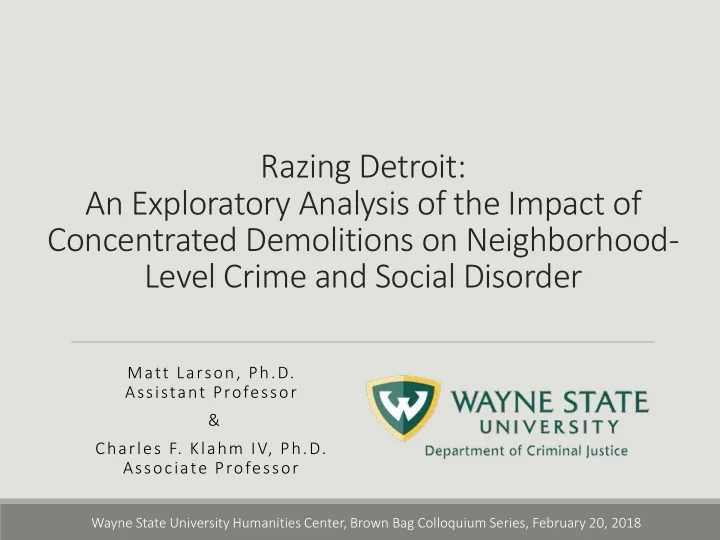

Razing Detroit: An Exploratory Analysis of the Impact of Concentrated Demolitions on Neighborhood- Level Crime and Social Disorder Matt Larson, Ph.D. Assistant Professor & Charles F. Klahm IV, Ph.D. Associate Professor Wayne State University Humanities Center, Brown Bag Colloquium Series, February 20, 2018
Motivating Social Problem HIS HISTORICAL EVENTS: ◦ Loss of population - waves of abandonment began in the 1950s ◦ In 1950 Detroit’s population was approximately 1.8 million (Sugrue, 1996) ◦ Racial tension and economic downturns led to significant migration ◦ In 2010 Detroit’s population was approximately 750,000 RECE CENT EVENTS: ◦ Subprime lending ◦ 2006 – 48% of Detroit mortgages were subprime (Ashton, 2010) ◦ 2009 – 63,000 homes went through mortgage foreclosure (Dewar, 2015) ◦ Blight and abandonment ◦ 2010 – 79,000 of Detroit’s structures were abandoned ( Mallach, 2012) ◦ Peaked at 85,000 after city’s bankruptcy in 2013 (Farley, 2015) ◦ Demolition program launched in 2014 ◦ Unprecedented, mass removal of abandoned homes ◦ What’s the impact of the mass demolition of abandoned homes
Community Optimism Source: WXYZ Detroit (2016)
Community Optimism Source: Dynamo Metrics (2015)
Guiding Theoretical Perspectives Social Disorganization Theory: ◦ Rich literature explicating the effects of social disorganization (Shaw & McKay, 1942) ◦ Most studies use indicators reflecting social dimensions of disorganization (e.g., poverty, density, female-headed households, etc. – for exception, see Sampson & Raudenbush, 2004) ◦ Original work discussed physical dimensions, too (e.g., dilapidated housing, abandoned buildings) Crime Prevention Through Environmental Design: ◦ Physical geography and design influence criminal opportunities (Jeffery, 1971) ◦ Territoriality (Crowe, 2000; Newman, 1972)
Guiding Theoretical Perspectives Situational Crime Prevention: ◦ Crime attractors ◦ Create well-known criminal opportunities (Brantingham & Brantingham, 1985) ◦ Opportunity for drug trafficking (Alexander & Powell, 2011) ◦ Increase in crime, generally (MacDonald, 2015) ◦ Increased home vacancy , more burglary (Jones & Pridemore, 2016) ◦ Provide locations with a lack of guardianship (Boessen & Hipp, 2015) ◦ Crime generators Broken Windows Theory: ◦ Wilson and Kelling (1982) explicate a theory of urban decay that implicates the breakdown of neighborhood social capital as a primary culprit for the evolution of criminal behavior.
Broken Windows Thesis Altered Behavior Less Informal Fear Generated (Less Interaction) Social Control Disorder Serious Crime (physical & social) Perception = No One Cares
Citizens’ Perceptions Source: WXYZ Detroit (2016)
Citizens’ Perceptions “Crooks, kille llers and lose sers tend to to in infest areas wit ith dead buil ildin ings, li like magg ggots on on a carcass” (H (Holm lmberg, g, 1998).
Current Study Research Questions: ◦ What is the impact of the concentrated removal of abandoned building/homes on neighborhood-level (1) crime and (2) disorder? Data Sources: Data Sources: ◦ Demolitions ◦ Demolitions ◦ Detroit Data Portal ◦ Detroit Data Portal ◦ Crime Incidents ◦ Crime Incidents ◦ Detroit Data Portal ◦ Detroit Data Portal ◦ Neighborhood characteristics ◦ Neighborhood characteristics ◦ American Community Survey (U.S. Census Bureau) ◦ American Community Survey (U.S. Census Bureau) Level of Analysis: ◦ Census tract vs. Census block group
Quinn Street, northern Detroit
Elmhurst & Rosa Parks, Detroit
Detroit’s Demolition Program ◦ Awarded over $250 million from the Hardest Hit Fund ◦ 85,000 vacant units (goal is to raze 40,000 by 2026) ◦ Since 2014, $207,880,047.39 has been spent on 13,513 demolitions ◦ Average cost per demolition = $15,383.71 Structures City Vacancy Rate Vacant Units Demolished 13,513 1 Detroit 23% 85,000 6,000 2 Cleveland 19% 40,000 200 2 St. Louis 19% 34,000 3,500 2 Buffalo 15% 23,000 405 2 Pittsburgh 13% 20,000 1 As of 2/18/2018; since program began in 2014 2 Estimate
Detroit’s Original 6 Hardest Hit Areas
Detroit’s Expanded Hardest Hit Areas (n=17)
Where Did Demolitions Actually Take Place? Source: City of Detroit Open Data Portal: https://data.detroitmi.gov/
All Demolitions 2014-2017 Source: City of Detroit Open Data Portal: https://data.detroitmi.gov/
Total Demolitions 2014-2017 # of demos # of BG % of BG 0 127 14.16 1-11 375 41.81 12-24 199 22.19 25-43 136 15.16 44-69 49 5.46 ≥ 70 11 1.23 Source: City of Detroit Open Data Portal: https://data.detroitmi.gov/
Methodological Issues • Original blight removal efforts now reach city-wide • Only 56% of demolitions have been in original HHF zones • Space…and “time” • Cross sectional analyses are insufficient • What happens after a demolition? • Various post-demolition outcomes exist • Neighborhoods in Detroit are ever-changing • e.g., Detroit Land Bank properties, new lighting infrastructure, PGL, etc. • Capturing the nature of ”effects” • Threshold effects? Short-term or long-term?
Moving Forward • Work through methodological issues • Try to assess what happens after demolitions occur (vacant parcel, community garden, redevelopment?) • Work with City of Detroit to conduct pre/posttest surveys of residents in block groups where demolitions are planned to occur • Try to assess the impact of the mass scale demolitions on mental and physical health outcomes
The end
Recommend
More recommend